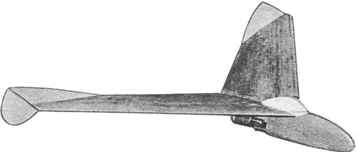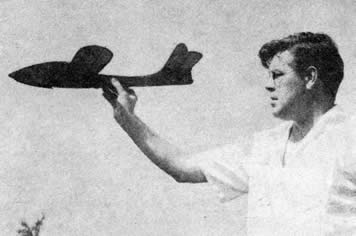
|
Jetwing
by Bill Dean

Click image to view or download enlarged dimensioned plan
and building and flying hints from Bill Dean


 -
Model Planes Annual 1949 (p. 44)
-
Model Planes Annual 1949 (p. 44)
|
 |
Bill Dean was quickly off the mark with models for the new Jetex motors that had come
on the market in June 1948.
Besides designing the Skyjet 100 kit for Keilkraft, he also designed this
simple sheet flying wing for the 100 unit. It was published in November 1948 in the
first of a new series of Model Aviation publications which Bill edited with Ron Warring.
Flown at the first Jetex contest at the 1948 Isle of Man
Rally, Jetwing gained second place. At the same rally, it also gained fourth place
in the Flying Wing Power event, "bearing out our opinion", said Bill, "that Jetex models
stand a good chance in open power events."
|

|
Swish
by Bill Winter

Click image to view or download enlarged dimensioned plan
and building and flying hints from Bill Winter
 -
Model Airplane News, Nov. 1948 (p. 27)
-
Model Airplane News, Nov. 1948 (p. 27)
|
 |

The credit for designing the first Jetex plan published in the United States belongs to Bill Winter.
Bill's plan for Swish was published just five months after the first Jetex motors were released onto the market. It took its name from the new powerplant's "gentle hissing sound, more like a swish".
For Bill, "this ship proved the most interesting and unusual project yet encountered". As for Swish's flying capabilities, Bill wrote:
"Make no mistake, the Swish will put up good flights. It is capable of a minimum of 75 feet altitude under power without soaring (which it does very well) and a duration of at least 1½ min."
|
|

|
Jetex Job
by Henry Struck

Click image to view or download enlarged dimensioned plan
and building and flying hints from Henry Struck
 -
Air Trails Pictorial, Feb. 1949 (p. 67)
-
Air Trails Pictorial, Feb. 1949 (p. 67)
|
 |
Henry Struck was another American who was quick off the mark with a Jetex design.
Early experiments by Wilmot Mansour and I.C.I. had demonstrated the suitability of tailless
models for Jetex power, and Henry followed this lead with his Jetex Job. He expressed
his excitement about the potential for novel designs, as well as an impressive grasp of
the novel characteristics of the new form of model motive power:
"Radically new and exciting designs are possible with this power supply. The reduction of drag assumes prime importance, as the ratio of the exhaust velocity to the model velocity determines the efficiency at which the motor is operating. Weight must be kept at a minimum, to permit the model to accelerate rapidly, without wasting the thrust available.
The Jetex unit fits neatly into the idea of a low-drag design. A pusher installation produces a sleek fuselage, with the small engine diameter of one inch fully cowled, provided cooling airflow over the unit is maintained."
|
Henry enjoyed "many excellent flights" with what he acknowledged was an experimental design, intended
"to test the ability of the Jetex unit".
|

|
Twin Boom 100
by Bill Gough

Click image to view or download enlarged dimensioned plan
and building and flying hints
 -
Model Airplane News, July 1950 (p.31)
-
Model Airplane News, July 1950 (p.31)
|
 |
Bill Gough "demonstrates two-handed launching technique, turning ship sideways to show Jetex unit". Writing in 1950, Bill tells of his delight in discovering the potential of Jetex 100 power:
"Upon receiving a Jetex 100 solid charge jet motor, the author was intrigued with its possibilities, and later set it up on a test stand with a small household fan tossing air towards the little engine for cooling.
"
Lo and behold! The thrust output was found to be excellent for its size. It was decided to mount this jet engine on a previous design, a "high start" twin boom glider model which had been developed by the writer during the war."
|
The result was this novel twin boom flyer, which "will climb steeply and steadily in a wide circle until it is very high up" |

|
Convair XF-92A by Lloyd Mosher

Click image to view or download enlarged dimensioned plan

 -
Air Trails, May 1951
-
Air Trails, May 1951
|
 |
On his plan, Lloyd Mosher names his little RTP model the Consolidated Vultee XF-92A. Consolidated Vultee became Convair, and the full-size craft is better known under that manufacturer’s name.
|
Jetex 100
by Al G Ackerman

Click image to view or download enlarged dimensioned plan
and building and flying hints
 -
Frank Zaic’s Model Aeronautic Year Book, 1953 (p. 104)
-
Frank Zaic’s Model Aeronautic Year Book, 1953 (p. 104)
|
 |
Al Ackerman (of Windsor, Ontario, Canada) said of his design for Jetex 100 power:
"Climbs straight out at 45° or completes one turn to right under power. Glide: Very wide rlght turn. Duration: 90 secs. or a little better in still damp evening air."
|
|
|